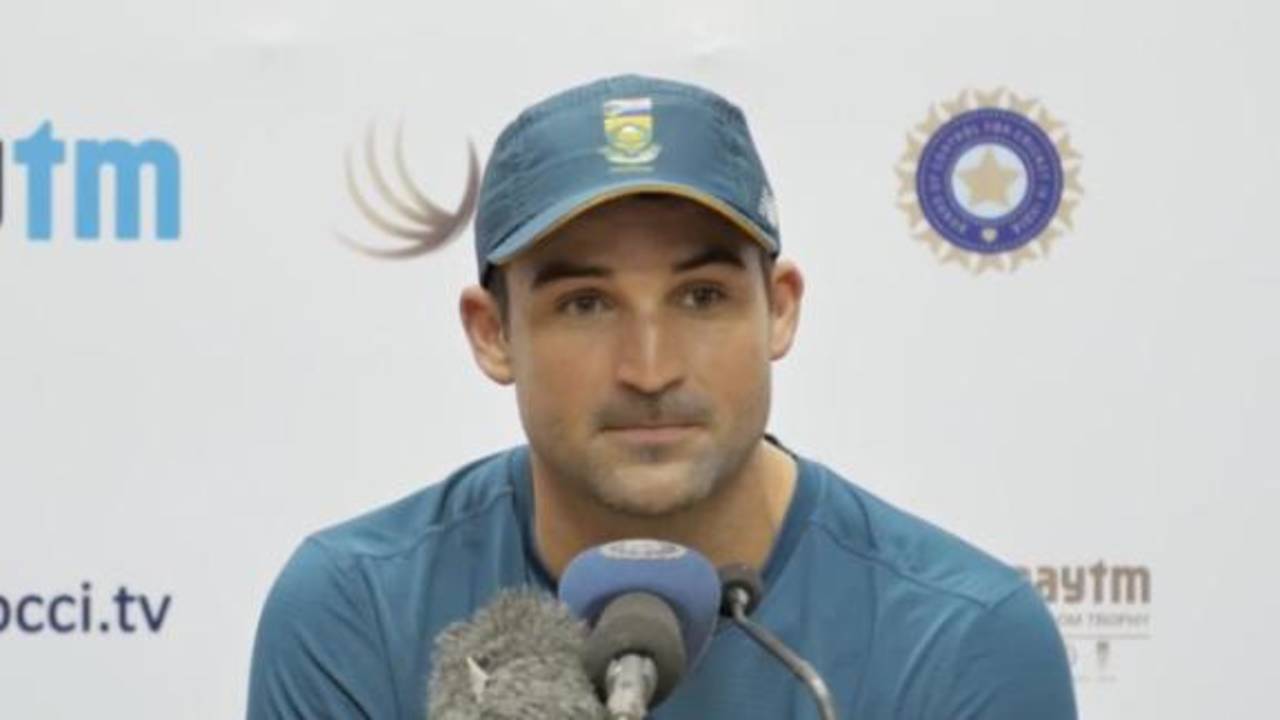Not a good cricket wicket - Elgar
South Africa's Dean Elgar has voiced his displeasure with what he believed was a "result wicket" in Mohali
Sidharth Monga in Mohali
05-Nov-2015
After India's batting coach Sanjay Bangar had repeatedly defended the track in Mohali, Dean Elgar, the opening batsman who nearly doubled his career wicket tally with a four-wicket haul, was asked what he thought of the pitch.
"Honestly?" he asked, and looked hesitantly at the South Africa media manager, without drawing any reaction from her whatsoever. Then he went on regardless: "I don't think it's a very good cricket wicket. It is my personal opinion. It is a result wicket, which is expected when you come here. But kudos to India, they are obviously going to prepare wickets like these against us, I'm sure. And we know coming here, it was going to be very different from what we are used to. So it's not a very good cricket wicket, but it is a result wicket, which can go either way."
It was a dry pitch, something Sunil Gavaskar said at the pitch report he had "never seen before". The middle part of the pitch was flat and low, and the good length scuffed up, offering slow but generous turn. It negated the South Africa fast bowlers, and brought it down to spin and reverse swing. India, not quite equal to the task, squandered the advantage of batting first and were bowled out on 201.
"It is a very challenging wicket," Bangar said. "I am not saying it is a good wicket or a bad wicket, but it is a very challenging wicket wherein run-making is not easy so I would say it looks 201 on the board, but it is actually worth far more than 201."
Bangar was asked that while the home advantage exists, what he thought of the pitch offering so much turn so early in the game. "When an Indian team goes overseas, you cannot say that the extent of seam movement, or the extent of movement in the air, there should be a fixed criteria," Bangar said. "'Okay if it swings this much or if it seams this much then only they are the ideal conditions. The extent of spin, seam or swing is something that cannot be fixed or measured. It is a challenge for all the batsmen. Equally taking wickets or scoring runs on such tracks is an art. Players will have to apply all their skills.
"I don't think it started to spin from the first over. In the first half it really played well. Most of the wickets, if you see, they were not really [because of spin]. The ball didn't really turn that much. I think it is a mental skill and a mental challenge for the batsmen to score runs on such wickets."
Elgar disagreed with the notion that green tracks outside Asia posed a similar challenge. "Well I'm sure it has its flip side as well," Elgar said. "I would think that generally when cricket is played on a green wicket, it lasts longer than it does on a spinning wicket. But yeah, I'm not really talking too much about this wicket. Mentioned what I wanted to mention and that's it."
When asked to compare it with the tracks in Sri Lanka and what he tried to do on this pitch, Elgar said all he had to do in Mohali was land it in "half-decent" areas. "It [the pitch] is a lot different," Elgar said. "It is like a day-four wicket now, the way I see it. So I batted on day one in Sri Lanka most days. So it is a lot different.
"With regards to my bowling, I think a lot of times when the batters face me, they don't want to go after me, and they become a little tentative. Fortunately the wicket had broken up quite a bit and there was quite a bit of rough. I just tried to land in a half-decent area. It worked out for me. I'm thankful that the batters were a little tentative against me, which is quite nice and worked in my favour and hopefully I can carry on."
The pitch has been a matter of much speculation leading up to the Test, not least because of India's recent demands for tracks that turn from ball one. The Indian camp remained tight-lipped about how the pitch was likely to behave, or even whether they were satisfied with what Daljit Singh, the Mohali curator, had rolled out for them. There was a long conversation between the team leadership - Virat Kohli and the assistant coaches - and Daljit three days before the Test after which brushes made of intertwined coir rope were used to dust parts of the surface. A groundsman said this was being done to bring some sheen to the surface. It must also be kept in mind this surface has not been relaid for 23 years.
Daljit is perhaps the only curator in the country who takes the reporters next to the pitch and explains to them the nature of the track and how it is expected to behave. This time, though, for some reason, he had that customary chat at the edge of the square, which meant nobody was allowed to see the pitch in the lead-up to the Test. Daljit was also uncharacteristically cagey about predicting the behaviour of the pitch.
Sidharth Monga is an assistant editor at ESPNcricinfo
